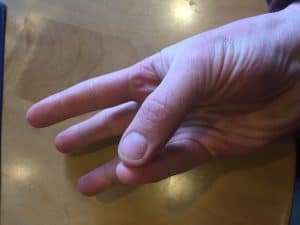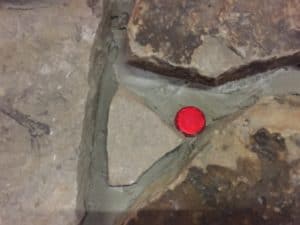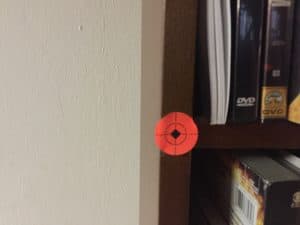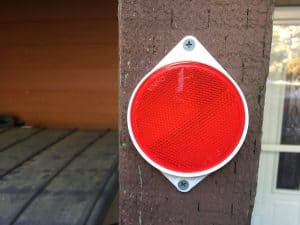I just ran into a video again from a couple of well known instructors who are great shooters. They that claimed that you shouldn’t practice a slow, deliberate trigger press because you don’t have time for that in a gunfight.
It was one of those times when I hung my head and shook it in sadness.
You see, while I agree with that sentiment, that advice is going to cause most shooters lots of frustration.
Whether a fast or slow trigger press is right for you all depends on context.
Why?
Because there are different training techniques that are appropriate at different times in your life as a shooter.
When you’re first starting out at a new skill…be it walking, driving, typing, or shooting, you need to be slow and deliberate.
You need to map the new movement patterns in the brain to make it a coordinated movement.
Once the movement is coordinated and controlled, speed comes naturally.
I can slap the snot out of the trigger and shoot 6″ groups with .14-.18 splits at 21 feet with a Glock 26…but it was a deliberate process to get to that point. (A process that I’m going to share with you)
If you go straight to speed before developing coordination, you’re going to sabotage your performance.
So today, we’re going to break down how to grip the pistol tightly and run the trigger quickly without disturbing sight alignment with sympathetic movement–it’s going to take a little explanation, but it’s pretty straight forward and the drill itself only takes about 1 minute.
In layman’s terms, sympathetic movement is when you try to move a joint in your body and you get movement from another joint at the same time that you didn’t plan on or want.
There are a few causes of sympathetic movement…here are 6 biggies:
- Speed. The faster you try to move your trigger finger, the more likely you’ll get sympathetic movement.
- Grip intensity. The tighter you grip, the more likely you’ll get sympathetic movement and, in fact, when I see left or low left groups, one of the first things I have shooters do is relax their shooting hand grip.
- Too heavy/long of trigger for your trigger finger. Heavy trigger, a fatigued/weak trigger finger, or too long of a trigger press for your trigger finger. When you don’t have enough strength to easily press the trigger back, the brain recruits additional muscles in the hand to get the job done.
- Stress level…specifically whether or not you’re in “startle” or fight-or-flight mode.
- How granular the map of your hand is in your brain. (we’ll cover this)
- The biggest factor combines with #5 and can mitigate the other 4…It’s how well developed and precise your neural pathways are for pressing the trigger straight to the rear while gripping and without moving your other fingers.
So, how do you make the jump from a slow, deliberate trigger press to quickly slapping the snot out of the trigger without compromising accuracy?
Fortunately, there’s a quick and easy process to improve both that will work for any shooter reading this…including you.
Let me start with the map of your hand in your brain. We’ve got 27 total bones in each hand.
And each of these bones and the joints between them are mapped to a specific part of the brain.
For someone who wears heavy mittens or swings an axe all day, there’s not much need for a detailed map of the hand in the brain, so the brain will prune detail on the map to improve efficiency. Over time, the map will look like a club with no individual fingers or joints.
They won’t be able to feel things very precisely and they will tend to move their fingers as a unit…kind of like a lobster. Typing is almost impossible. If you think of it in terms of TV resolution, it’s like trying to watch a TV show on a watch.
Some people, like pianists, illusionists, detailed machinists, and brain surgeons need to have VERY granular maps of their hands in their brain. They need detailed nerve maps and they need precise muscle control. Some can feel the difference of a few thousandths of an inch and can make incredibly precise movements. Their resolution would be like the latest 4K high definition.
 To experience practical example of this, try looking at the palm of your hand and touch each finger to your thumb, one at a time, without moving any other finger. You’ll probably find that you get sympathetic movement, even if you don’t want it to happen. As a general rule, the quicker you do this drill, the more sympathetic movement you’ll have. The more granular the map in your brain, the less sympathetic movement you’ll have…even at higher and higher speeds.
To experience practical example of this, try looking at the palm of your hand and touch each finger to your thumb, one at a time, without moving any other finger. You’ll probably find that you get sympathetic movement, even if you don’t want it to happen. As a general rule, the quicker you do this drill, the more sympathetic movement you’ll have. The more granular the map in your brain, the less sympathetic movement you’ll have…even at higher and higher speeds.
The same thing happens with shooting. If your brain doesn’t have a highly developed script to follow for moving the end of the trigger finger straight back and forth while gripping with the rest of the muscles in the hands, you’re going to get sympathetic movement that will mess up sight alignment and cause loose groups. For right handed shooters, this usually shows up as groups to the left or low left.
One easy way to improve your trigger finger isolation is with coin rolling and other slight-of-hand tricks.
Another is with the Trigger Slap Drill that I’m going to share with you.
What you want to do is get a baseline of how quickly you can do 5 slow, deliberate dry fire reps while keeping your sights lined up with a 1” target and then improve that speed over time. I call it the trigger slap drill because eventually you’ll get to where you’re shooting so fast that you’ll probably find that you’re slapping the trigger without it affecting your accuracy.
Here’s how to do it:
You’re going to need to remove all ammo from the training area. You’ll also need a pistol that you’ve rendered inert for dry fire practice, an airsoft pistol, a Dry Fire Pistol from SIRT, Dry Fire Cord in your carry pistol, or some other platform with a moving trigger.
Finally, you’re also going to need a metronome or a metronome app on your phone. They’re free. I use “MetroTimer.”
Start off by picking a 1” target at chest-to-eye level and stand 6 feet away. I like using mini-driveway reflectors or Birchwood Casey targets.


Set the metronome to 1 beat every 2 seconds or 30 beats per minute. That’s 2 seconds to press the trigger, release, and start the next press.
Aim at the target and dry fire press the trigger 5 times in a row at that 2 second pace while keeping your sights aligned with the target throughout. Simply press and release. Press and release. Don’t rack the slide between reps.
If you’re using a laser, it’s easy to tell how you’re doing.
If you’re not using a laser, what you need to do is watch your front sight the entire time and make sure that your sight alignment doesn’t leave the target. This is called “calling your shots” and it’s a very valuable skill for shooting.
On some guns, the trigger will have a dead trigger if you don’t rack the slide between reps.
On pistols with a dead trigger, you can hold the slide out of battery with our Dry Fire Cord or by putting a piece of 550 cord out the side of the ejection port and get a resetting trigger. If you do this, make sure that the cord you’re using is thick enough that you don’t get a clicking sound as you’re pressing the trigger. It helps to gently ride the slide forward against the 550 cord instead of letting it fly.
With an airsoft, you can either do the drill with a dead trigger or you can push down the follower in an empty magazine, jam a piece of masking tape in, and it won’t engage the slide release and lock back on an empty mag anymore.
On revolvers or semi-autos that have a double action first shot like some Sigs, Berettas, H&K, etc., your times will be slower and your finger will get a workout, but the drill remains the same.
How’d you do?
If it was easy, back up to 10 feet and increase your cadence 10 beats per second and repeat until you find the fastest speed where you can keep the sights on target for all 5 shots.
If it was hard, slow down 10 beats per second and repeat until you find the speed where you CAN keep the sights on target for the entire 5 shots. You can also switch to a bigger target, like a 2” driveway reflector. I use these a lot for practice with my Dry Fire Pistols.

If you get a bigger target and slow down and still can’t keep your sights on the target, it may be an indication that your hand or trigger finger aren’t compatible with your pistol or trigger. Hand size, hand & finger strength, grip size, trigger pull length, and trigger weight can make a world of difference. In fact, switching from the wrong gun (for you) to the right gun (for you) can make shooting go from something you endure to something you love.
When you figure out the speed that you can do 5 reps, record your training platform, distance, target size, and your speed and then do 10-20 seconds of reps at that cadence.
For reference, my metronome (MetroTimer app on the iTunes store) goes up to 250 beats per minute and I practice 1” group at 10-15 feet for 20 seconds at that pace with my Dry Fire Pistol. I’m slower when I’m using a Sig, H&K, or other pistol with a long, double action trigger press on the first shot.
As a comparison, world champion shooters shooting light, single action triggers shoot bursts as fast as 600 rounds per minute with a live gun.
All of that to say, don’t really get too caught up on your speed compared to others. Just get your baseline and work to improve it.
Play around with it…
Try it with a tighter shooting hand grip and see how it affects your speed.
And try it with a looser shooting hand grip and see how it affects your speed.
Try it one handed (with each hand) with a tight grip.
For the next several days, push the envelope with 10-20 second sets at the fastest speed you can shoot and still keep your sights aligned with the target. Just go for raw speed and use however loose of a grip you need to maximize speed.
Then, pick a speed that’s less than your max speed and work on gripping as tightly as you can while still maintaining accuracy. The tighter your grip, the faster you’ll be able to get back on target for your next shot with live fire, BUT the more likely that you’ll have sympathetic movement while pressing the trigger.
It’ll only take a minute or so per day, and it’ll have a huge impact on your trigger manipulation skills.
I suggest working both ends of the spectrum…work on pure speed with a loose grip and work on increasing your speed while maintaining as tight of a grip as you can.
You’ll have up days and down days, but the general trend should be that you’ll get noticeably quicker in just a few days and dramatically quicker over a couple of weeks. Of course, you may not realize how much you’re improving if you don’t keep track…so keep track.
When you max out your speed, start focusing on increasing grip intensity at your max speed.
*Spoiler alert*
You’re going to be able to do this quicker without recoil than with recoil.
That’s not the point.
The point is to train the brain how to articulate the trigger finger quicker without your wrist or other fingers moving.
I’m always looking for data. If you would, try this drill today and share your baseline below…please share the platform you’re using, a rough estimate of how tight you’re gripping (100%, 50%, etc.), your distance from the target, size of the target, and what your cadence is.
Then come back to it after doing the drills for a week or two and share your improvement.
And, for more high speed techniques for improving as quickly as possible with a pistol in as little time as possible, check out our home study course, >HERE<. It incorporates more than a dozen accelerated learning techniques to help you shoot up to 2x quicker and 2x more accurately in just 21 days for less than the cost of a single trip to the range.
Questions? Comments? Want to see video of this drill? Fire away below. to share your thoughts.

2 Comments
jerry levine
January 31, 2018Greetings. I would like to see the video.
Thank you,
jerry
[…] had an article last week on the blog where I talked about how to improve your trigger control by isolating the movement of […]
Leave A Response